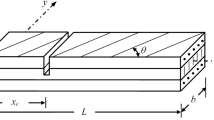Abstract
The aim of crack detection and localization is to minimize sudden failures of rotating machines and static structures while in operation. For this purpose, an impact hammer test is performed in cracked and no crack beams made of steel and composite material to obtain the change in natural frequencies and mode shapes. The impact hammer test is performed with the help of four-channel vibration analyzer, impact hammer and uniaxial accelerometer. A change in natural frequencies is used to detect the crack present in the steel and composite beams. Test data of first three natural frequencies obtained from an impact hammer test on different cracked steel and composite beams are used to train the normalized mode shapes algorithm and plot the mode shapes of first three natural frequencies. The intersection of first three normalized mode shapes is used to estimate the crack location with very high accuracy. From the experimental results, it is confirmed that the change in natural frequencies and intersection of first three normalized mode shapes are used for detection and localization of crack present in the steel and composite beams, respectively. When compared to other methods in the literature for detecting crack location based on mode shape curvature, the methodology used in this paper is more accurate.











Similar content being viewed by others
References
K.V.R. Prasad, V. Singh, Experimental modal analysis of induction machine stator end windings of driving end and non-driving end to predict the looseness. J. Failure Anal. Prevent. 22, 1151–1163 (2022)
M. Aryayi, M.R. Hadavi, S. Nickabadi, R. Ansari, Changes of natural frequencies of shafts due to pitting corrosion. J. Failure Anal. Prevent. 22, 1144–1150 (2022)
J.P. Cherrez, D. Cardenas, O. Probst, Experimental detection and measurement of crack-type damage features in composite thin-wall beams using modal analysis. Sensors. 21, 1–23 (2021)
M. Elshamy, W.A. Crosby, M. Elhadary, Crack detection of cantilever beam by natural frequency tracking using experimental and finite element analysis. Alex. Eng. J. 57(4), 3755–3766 (2018)
S.W. Prashant, V.N. Chouguleb, C.M. Anirban, Investigation on modal parameters of rectangular cantilever beam using experimental modal analysis. Mater. Today Proc. 2, 2121–2130 (2015)
H. Nahvi, M. Jabbari, Crack detection in beams using experimental modal data and finite element modal. Int. J. Mech. Sci. 47, 1477–1497 (2005)
D.K. Agarwallaa, D.R. Parhi, Effect of crack on modal parameters of a cantilever beam subjected to vibration. Proc. Eng. 51, 665–659 (2013)
G.M. Owolabi, A.S.J. Swamidas, R. Seshadri, Crack detection in beams using changes in frequencies and amplitudes of frequency response functions. J. Sound Vib. 265, 1–22 (2003)
M.S. Maksimovic, I.V. Vasovic, K.S. Maksimovic, N. Trisovic, S.M. Maksimovic, Residual life estimation of cracked aircraft structural components. FME Trans. 46, 124–128 (2018)
I. Mishra, S.K. Sahu, Modal analysis of woven fiber composite plates with different boundary conditions. Int. J. Struct. Stab. Dyn. 15(1), 1–17 (2015)
P. Pushparaj, B. Suresha, Free vibration analysis of laminated composite plates using finite element method. Polym. Polym. Compos. 24, 529–538 (2016)
X. Lei, W. Rui, Z. Shujie, L. Yong, Vibration characteristics of glass fabric/epoxy composites with different woven structures. J. Compos. Mater. 45(10), 1069–1076 (2011)
W. Lian, W. Yao, Fatigue life prediction of composite laminates by FEA simulation method. Int. J. Fatigue. 32, 123–133 (2010)
D. Vaishali, V. Gaurang, Identification of crack damage in reinforced concrete beams using mode shape based methods. Civ. Environ. Res. 3, 24–29 (2013)
O.S. Salawu, Detection of structural damage through changes: a review. Eng. Struct. 19, 718–723 (1997)
R.K. Behera, A. Pandeyb, D.R. Parhic, Numerical and experimental verification of a method for prognosis of inclined edge crack in cantilever beam based on synthesis of mode shapes. Proc. Technol. 14, 67–74 (2014)
S. Shkelzen, C. Yusuf, Free vibration analysis of functionally graded beams with cracks. J. Appl. Comput. Mech. 6(4), 908–919 (2020)
S. Zizheng, Z. Xiaoying, Z. Yiming, Cracking elements method for simulating complex crack growth. J. Appl. Comput. Mech. 5(3), 552–562 (2019)
S.P. Chaphalkar, N.K. Subhash, M.M. Arun, Modal analysis of cantilever beam structure using finite element analysis and experimental analysis. Am. J. Eng. Res. 4(10), 178–185 (2015)
D. Hajializadeh, E.J. Obrien, A.J.O. Conno, Virtual structural health monitoring and remaining life prediction of steel bridges. Can. J. Civ. Eng. 44(4), 264–273 (2017)
J. Kong, Crane residual life estimation method based on artificial neural networks, Bio Technol. Indian J. 10(11), 5674–5681 (2014)
F. Leonard, J. Lanteigne, S. Lalonde, Free vibration behaviors of a cracked cantilever beam and crack detection. Mech. Syst. Signal Process. 15(3), 529–548 (2001)
O. Sadettin, Analysis of free and forced vibration of a cracked cantilever beam. NDT E Int. 40(6), 443–450 (2007)
Y.L. Hu, E. Madenci, Peridynamics for fatigue life and residual strength prediction of composite laminates. Compos. Struct. 160, 169–184 (2017)
Author information
Authors and Affiliations
Corresponding author
Additional information
Publisher's Note
Springer Nature remains neutral with regard to jurisdictional claims in published maps and institutional affiliations.
Rights and permissions
About this article
Cite this article
Ramakrishna, S., Sathish, J., Raj Kumar, V.D. et al. Experimental Investigation on Crack Localization in Steel and Composite Structures by Intersection of First Three Normalized Mode Shape Curves. J Fail. Anal. and Preven. 22, 1970–1981 (2022). https://doi.org/10.1007/s11668-022-01486-7
Received:
Revised:
Accepted:
Published:
Issue Date:
DOI: https://doi.org/10.1007/s11668-022-01486-7




